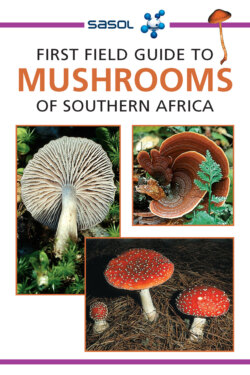Читать книгу First Field Guide to Mushrooms of Southern Africa - Margo Branch - Страница 15
На сайте Литреса книга снята с продажи.
Death Cap
ОглавлениеAmanita phalloides
Other names: Slangkos (Afr), Duiwelsbrood (Afr)
Learn to identify the deadly Death Cap by these combined features: a cup (volvaG) at the base of the stem, a ring and white gills.
Where found: The Death Cap appears early in the rainy season under pines, poplars and oaks. It is widespread throughout southern Africa and the rest of the world.
Description: Cap: 8–15 cm diameter. Smooth, shiny when wet. Colour ranges from smoky olive to yellowish-green, buff or almost white. Dome-shaped, becoming flat with a smooth margin. Stem: 5–15 cm long, 8–25 mm wide. White or flushed with yellowish-green. Bulbous base enclosed in a distinct cup (volvaG). Ring: Persistent; white; membranous. Gills: White; free; crowded; with smooth edges. Flesh: Thin; white, with faint yellow tinge. Sickly sweet to foetid smell. Spores: White.
Edibility: Deadly poisonous. This lethal mushroom accounts for 90% of all mushroom fatalities worldwide. Consumption of just 30 g is enough to kill an adult. It is estimated that over 50% of those who have eaten Amanita phalloides do not survive. The symptoms, which include stomach pains, vomiting, thirst and diarrhoea, only appear 6–24 hours after ingestion, by which time the amatoxins will have caused extensive kidney and liver failure. If poisoning is suspected it is essential to get treatment as soon as possible. Repeated doses of activated charcoal together with a saline cathartic, and detoxification by forced diuresis and blood transfusions is recommended.
